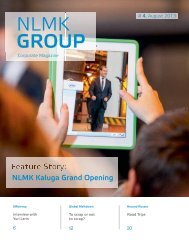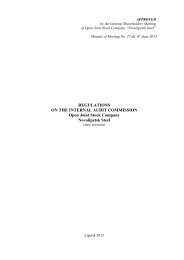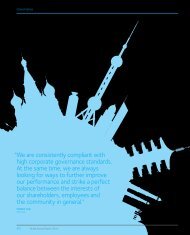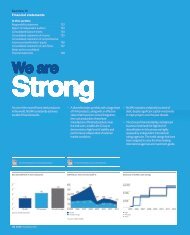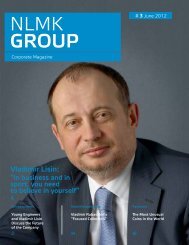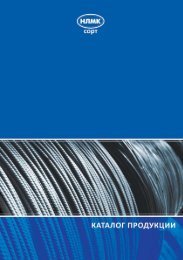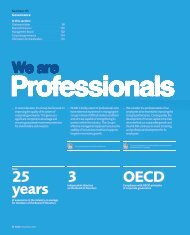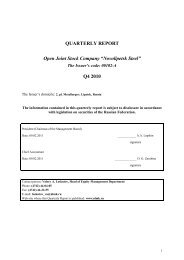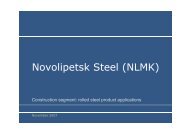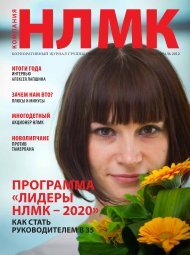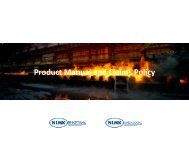Create successful ePaper yourself
Turn your PDF publications into a flip-book with our unique Google optimized e-Paper software.
11<br />
Economy and Production DEVELOPMENT<br />
NICOLAS MOSEL,<br />
PROJECT MANAGER FOR THE<br />
CONSTRUCTION OF BF-7<br />
standards, and incorporates best<br />
available technology solutions.<br />
Some challenges had to be resolved<br />
during the construction phase.<br />
The first challenge was to clearly<br />
define the responsibilities of<br />
<strong>NLMK</strong> and Paul Wurth in terms<br />
of the workload and deliveries.<br />
The second challenge was to<br />
select and apply a number of new<br />
technological solutions which had<br />
not been used before by <strong>NLMK</strong><br />
experts. For example, the closed<br />
water circuits which are used to<br />
cool the casing of the furnace. We<br />
are confident that the combination<br />
of new technology and existing<br />
operation and maintenance<br />
skills will result in very strong<br />
performance by BF-7.<br />
Q: What makes BF-7 distinct?<br />
Is it different from facilities<br />
used in the West, is it inferior or<br />
superior?<br />
SK: Blast Furnace No. 7 is the<br />
first furnace in the former Soviet<br />
countries designed by a foreign<br />
company. The Soviet blast furnace<br />
design has a long tradition and<br />
Paul Wurth had the opportunity<br />
to share experience with your<br />
engineers. We would like to stress<br />
that many ideas suggested by<br />
engineers from Lipetsk and Russia<br />
were incorporated into the design<br />
and construction of BF-7, making<br />
it truly a product of international<br />
cooperation.<br />
NM: Essentially, any blast furnace<br />
is unique, and is distinguished<br />
by a distinct combination of raw<br />
materials, the design philosophy<br />
and the expectations of the client.<br />
It is therefore very difficult to<br />
make comparisons between blast<br />
furnaces. But just by seeing this<br />
facility once you can tell that it is<br />
different in terms of scale. More<br />
importantly, BF-7 is equipped<br />
with all appropriate safety<br />
features, in full compliance with<br />
Russian requirements applicable<br />
to metallurgical operations. Many<br />
other metallurgical facilities dim in<br />
comparison to the size of BF-7 and<br />
the extent of modern technology it<br />
utilizes. <strong>NLMK</strong> can be truly proud<br />
of its new and modern facility. And<br />
Paul Wurth, in its turn, will take<br />
pride in it as one of its latest and<br />
most advanced designs.<br />
Q: Please tell us more about the<br />
various processes and equipment<br />
proposed by Paul Wurth for BF-7?<br />
How would <strong>NLMK</strong> benefit from<br />
their use?<br />
SK: Firstly, it is the design of the<br />
blast furnace. It is a free-standing<br />
furnace utilizing modern refractory<br />
and cooling solutions which include<br />
copper cooling plates and a thinwalled<br />
riser equipped with closedcircuit<br />
cooling systems, and a most<br />
advanced air supply system for<br />
cold air blasting. This will ensure<br />
high operability and a long service<br />
life. An up-to-date charge make<br />
up solution, bell-less top charging,<br />
pulverized coal injection, reliable<br />
hydraulic equipment at the foundry,<br />
multiple process data recorders<br />
and a top notch automation system<br />
employing mathematical models<br />
and the Sachem expert system will<br />
ensure BF’s sustained performance<br />
in line with expectations and<br />
contract requirements.<br />
Q: What will be the<br />
environmental impact of BF-7<br />
operations? Can you really say<br />
that you have done your best and<br />
have employed the most effective<br />
methods to minimize the<br />
blast furnace’s environmental<br />
footprint?<br />
NM: The project utilizes all the<br />
best available technology to<br />
protect the environment. Dry<br />
scrubbing of waste gases is<br />
performed in a high-efficiency<br />
tangential cyclone installation<br />
which is followed by wet<br />
scrubbing. This approach helps<br />
to reduce significantly the<br />
amount of dust collected during<br />
wet scrubbing. The dust which<br />
gets separated in the cyclone<br />
can be further processed at the<br />
sintering plant for further use<br />
in the blast furnace. This will<br />
reduce the amount of waste<br />
requiring recycling or disposal.<br />
The bell-less top charging system<br />
employs nitrogen for secondary<br />
pressure equalization, and<br />
this helps reduce atmospheric<br />
emissions of contaminated blast<br />
furnace gas. A silencer is used<br />
to reduce noise generated by the<br />
pressure equalization equipment<br />
to acceptable levels. The cast<br />
house air cleaning system was<br />
designed in such a way so as to<br />
provide a comfortable working<br />
environment. The use of blast<br />
furnace gas to generate electric



